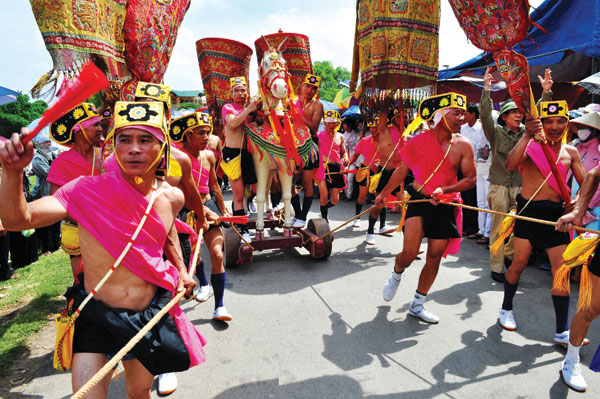(No.9, Vol.6,Nov-Dec 2016 Vietnam Heritage Magazine)


Photos by Nguyen Duy Hau at the Giong festival, Phu Dong Commune, Gia Lam Dist., Hanoi, 2011
An elaborate ceremony
marks the triumph of the Viet
over the An people.
The story of Saint Giong is one of the most beautiful and glorious legends of the Viet people about their spirit and strength in the fight against aggressors to protect the Fatherland.
Memory in a legend
It has been told that in the reign of the 6th Hung King, there was an old couple, praised for their diligence and kindness. They craved to have a child. Once, in the fields, the wife saw a gigantic footprint and tried to match her foot to it. Back home, she found herself pregnant, and twelve months later, she gave birth to a bright-faced boy. The couple was beyond happiness. But strangely, after three years, the child still didn’t walk nor talk. He simply lay there quietly.
Then the An aggressors invaded our country. They were so strong, and the King was worried. He sent emissaries everywhere to find a saviour. Hearing the trumpet sound, the child suddenly said, ‘Mom, I want to talk to the emissary.’ To the man, he said, ‘Please tell the King, with an iron horse, iron armour and an iron staff, I will crush the enemy.’
Stunned and exuberant, the emissary brought the news to the court. The King ordered his artisan smiths to use all the resources needed to quickly fulfil the boy’s demand. Even more fascinating, after meeting the emissary, the boy grew at an enormous rate. The old couple couldn’t keep up with his eating spree and had to ask their neighbours for help. So the whole village gave all their savings just to feed him.
The enemy had reached Buffalo Mountain. The situation was critical, and the people were scared, just as the emissary brought the iron horse, armour and staff to the village. The boy stood up ten feet tall, stately and august. He came over and patted the horse on the back. The horse neighed thunderously. The young knight put on his armour, took the staff and mounted. The horse made mile-long strides towards the enemy. It spewed fire. The young knight smashed left and right with his staff. Wave after wave of the enemy troops were swept away. His staff broken, the young knight uprooted golden bamboo clumps on the road sides to crush the enemy. Their lines broken, they started to stampede. The young knight pursued them to the foot of Soc Mountain. There, he rode to the top, removed his armour, and slowly soared up to heaven.
Hung King, without any means to reward the young knight for his service, bestowed on him the title of ‘Phu Dong, Heavenly King’, and built his temple in his native village. The temple is still standing in the village of Phu Dong, called Giong by the folks. Every fourth month of a lunar year, they have a big festival. They say that the fire the horse spat turned the bamboo in Gia Binh District in to the glossy yellow colour we see today. It also burned a village, which since then has been named The Burnt Village. The horse hooves left pond after pond on the earth’s face.
Memory in rituals
The Giong festival is a traditional yearly celebration in many places around Hanoi in order to commemorate and extol the deeds of the legendary Saint of Giong.
The official Giong festival in Phu Dong takes place on the 8th and 9th days of the 4th lunar month every year in Phu Dong commune, Gia Lam district, in Hanoi, which is the native place of Phu Dong Heavenly King. To express folklore ideas and philosophy, the festival has very unique shows. Prof. Nguyen Van Huyen called it ‘the fight show.’ We would call it a ‘chess show’. The chess pieces are divided into 2 sides. There are ‘hieu’ who were generals under Giong; ‘phu gia’ is his army. The opposite side is called the ‘lost souls’, representing the aggressors. ‘Ai Lao’ group, which includes ‘Tiger Lords’, is a composite army. ‘Red Shirt Ville’ is the youth’s recon force. ‘Black Shirt Ville’ is a paramilitary force. Giong festival is like a huge chess board with hundreds of pieces. The props, dresses, chess pieces and acts all carry deep meanings of popular wisdom. Each act is a procession accompanied by a different drum tone and rhythm, representing reconnaissance operations, arms forging, peace negotiations, and brutal battles.


The shows in the Giong festival are not only entertaining, but also highly symbolic. The imposing flag and the flag dance of the Flag Lord (representing Saint Giong) show the way of training the troops to win in the battles. The propitious and contrary flag movements show flexibility of manoeuvres. The official army has up to 120 shirtless troopers in loin-cloths. They wear melon-shaped hats with nine tiny dragons on the top that represent the earth, and carry a half-moon bag on their shoulders, which represents heaven. They also have a paper fan in their hand which they fold and unfold under the signals of two commanders, Xuong and Xuat. The fan represents a weapon whose movement the enemy cannot see. Everything is merged into an invincible force, when the soldier is imbued with the spirit of the earth and heaven of the native land. The show involves 28 young girls dressed as enemy generals, representing 28 armies of An aggressors.
The article in Vietnamese was printed on www.vicas.org.vn

